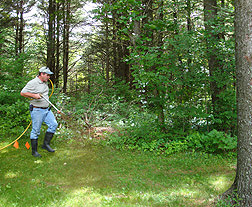This page has been archived and is being provided for reference purposes only. The page is no longer being updated, and therefore, links on the page may be invalid.
| Read the magazine story to find out more. |
|
|
Natural Tick Control Tested
By Jan SuszkiwJanuary 12, 2011
Nootkatone, a component of essential oil in grapefruit peels and other sources, is used in many food, beverage and personal-care products because of its clean, citrusy taste and smell.
Now, nootkatone may find another use: repelling blacklegged deer ticks that spread Lyme disease. U.S. Department of Agriculture (USDA) entomologist Bob Behle is investigating the possibility with Kirby Stafford, an entomologist at the Connecticut Agricultural Experiment Station (CAES) in New Haven, Conn.
Stafford began researching nootkatone's tick repellency in 2008 and sought Behle's formulation expertise when it became apparent the essential oil lacked sufficient residual activity to kill the tick's tiny nymph stage, which is more likely to transmit the Lyme disease bacterium than the larger, easier-to-spot adults.
In studies at the Crop Bioprotection Research Unit, operated in Peoria, Ill., by the Agricultural Research Service (ARS), Behle and colleagues refined a spray-dry procedure that uses lignin to encapsulate the nootkatone. ARS is USDA's principal intramural scientific research agency.
In nature, lignin acts like a molecular mortar that binds plant cell walls. In this instance, the lignin served as semipermeable packaging that extended nootkatone's residual activity and improved its effectiveness.
In greenhouse tests, the lignin-encapsulated (LE) nootkatone lasted longer than a previously tried formulation, known as emulsified concentrate (EC), and caused less harm (phytotoxicity) to cabbage plants when applied at standard field rates. No signs of plant damage were observed when researchers applied the LE formulation in outdoor trials, conducted in 2009 on residential properties. Just as importantly, no live ticks were recovered from treated sites.
Another round of tests was conducted this past June on nine residential properties—five of them using another nootkatone-encapsulating formulation devised by Behle.
In 2009, the U.S. Centers for Disease Control and Prevention reported 29,959 confirmed cases of Lyme disease, which can affect the joints, heart and nervous system of afflicted individuals if left untreated.
Read more about the research in the January 2011 issue of Agricultural Research magazine.

